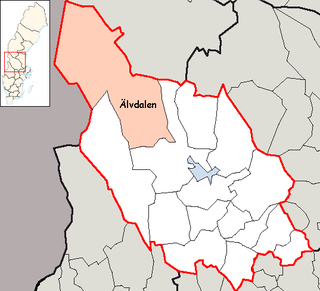
Älvdalen Municipality is a municipality in Dalarna County in central Sweden. Its seat is located in the town of Älvdalen.

Phonolite is an uncommon volcanic rock, of intermediate chemical composition between felsic and mafic, with texture ranging from aphanitic (fine-grain) to porphyritic.

Nepheline syenite is a holocrystalline plutonic rock that consists largely of nepheline and alkali feldspar. The rocks are mostly pale colored, grey or pink, and in general appearance they are not unlike granites, but dark green varieties are also known. Phonolite is the fine-grained extrusive equivalent.

Särna is a locality situated in Älvdalen Municipality, Dalarna County, Sweden with 719 inhabitants in 2010.

Femunden is Norway's third largest lake and the second largest natural lake in Norway. It is located in Hedmark and Trøndelag counties in Norway, just 13 kilometres (8.1 mi) west of the border with Sweden. The lake lies primarily in the municipality of Engerdal and also smaller parts are located in the municipalities of Os (Hedmark) and Røros (Trøndelag). Femundsmarka National Park borders the northeastern part of the lake.

Østerdalen is a valley and traditional district in Hedmark County, in Eastern Norway. It consists of the municipalities Rendalen, Alvdal, Folldal, Tynset, Tolga and Os in the north, Elverum, Stor-Elvdal, Engerdal, Trysil and Åmot in the south. It historically included Särna and Idre, today in Sweden.

Carbonatite is a type of intrusive or extrusive igneous rock defined by mineralogic composition consisting of greater than 50% carbonate minerals. Carbonatites may be confused with marble and may require geochemical verification.
Municipal List was a local political party in Älvdalen, Sweden.
The Oslo Graben or Oslo Rift is a graben formed during a geologic rifting event in Permian time, the last phase of the Variscan orogeny. The main graben forming period began in the late Carboniferous, which culminated with rift formation and volcanism, with associated rhomb porphyry lava flows. This activity was followed by uplifting, and ended with intrusions about 65 million years after the onset of the formation. It is located in the area around the Norwegian capital Oslo.
Dalecarlian is a group of dialects or unofficial languages spoken in Dalecarlia (Dalarna), Sweden. They are mutually unintelligible with Swedish. The best-known outside the area is Elfdalian.

A rare-earth mineral contains one or more rare-earth elements as major metal constituents. Rare-earth minerals are usually found in association with alkaline to peralkaline igneous complexes, in pegmatites associated with alkaline magmas and in or associated with carbonatite intrusives. Perovskite mineral phases are common hosts to rare-earth elements within the alkaline complexes. Mantle-derived carbonate melts are also carriers of the rare earths. Hydrothermal deposits associated with alkaline magmatism contain a variety of rare-earth minerals.

Idre is a locality and ski resort situated in Älvdalen Municipality, Dalarna County, Sweden with 794 inhabitants in 2010. It was also a historical parish and former municipality.
Banalsite is a rare barium, sodium aluminium silicate mineral with formula: BaNa2Al4Si4O16. Banalsite is a tectosilicate of the feldspar group.

Sarnaism or Sarna, also known as Sariism or Adiism, is the collective designation of the indigenous religions of the Adivasi populations of the states of Jharkhand, Odisha, West Bengal, Bihar, Madhya Pradesh, Maharashtra and Chhattisgarh, centred around the worship of nature represented by trees. Followers of these religions primarily belong to the Munda, Ho, Bhumij, Santal, Gond, Baiga and Khuruk ethnic groups.
Harry von Eckermann (1886–1969) was a Swedish industrialist, mineralogist and geologist. His studies were centered around anorogenic alkaline igneous rocks occurring in the Baltic Shield. Following this line he studied the Alnö Complex, Norra Kärr Alkaline Complex and various Rapakivi granites.
Norra Kärr or Norra Kärr Alkaline Complex is an intrusive complex cropping out at the boundary between Östergötland and Småland, Sweden. The complex is chiefly made up of peralkaline nepheline syenite and is rich in exotic minerals. Rocks of the complex intruded into the Paleoproterozoic-aged Växjo granites of the Transscandinavian Igneous Belt. Alfred Elis Törnebohm was the first to describe the rocks of Norra Kärr in 1906. Norra Kärr was discovered a few years earlier during regional geological maping by the Swedish Geological Survey. The complex derives its name from a local farm, which translates into English as "Northern Fen". In 1968 Harry von Eckermann published his investigations on the complex defining its boundaries and confirming the view of it as an intrusion.












